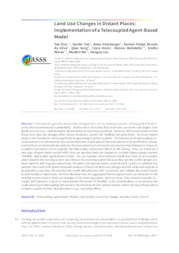Land-use changes in distant places: implementation of a telecoupled agent-based model.
Land-use changes in distant places: implementation of a telecoupled agent-based model.
Author(s): DOU, Y.; YAO, G.; HERZBERGER, A.; SILVA, R. F. B. da; SONG, Q.; HOVIS, C.; BATISTELLA, M.; MORAN, E.; WU, W.; LIU, J.
Summary: Abstract: International agricultural trade has changed land uses in trading countries, altering global food security and environmental sustainability. Studies have concluded that local land-use drivers are largely from global sources (e.g., trade increases deforestation in exporting countries). However, little is known about how these local land-use changes affect distant locations, namely the feedback between them. Yet these distant impacts and feedbacks can be significant for governing local land systems. The framework of telecoupling (i.e., socioeconomic-environmental interactions between distant places) has been shown to be an effective conceptual tool to study international trade and the associated socio-economic and environmental impacts. However, a systems simulation tool to quantify the telecoupled causes and effects is still lacking. Here, we construct a new type of agent-based model (ABM) that can simulate land-use changes at multiple distant places (namely TeleABM, telecoupled agent-based model). We use soybean trade between Brazil and China as an example, where Brazil is the sending system and China is the receiving system because they are the world?s largest soybean exporter and importer respectively. We select one representative county in each country to calibrate and validate the model with spatio-temporal analysis of historical land-use changes and the empirical analysis of household survey data. We describe the model following the ODD+D protocol, and validate the model results in each location respectively. We then illustrate how the aggregated farmer agents? land-use behaviors in the sending system result in land-use changes in the receiving system, and vice versa. One scenario example (i.e., a high-tariff scenario) is given to demonstrate the results of TeleABM. Such a model allows us to advance the understanding of telecoupling features and the influence on land system science, and to test hypotheses about complex coupled human-natural systems (e.g., cascading effect).
Publication year: 2020
Types of publication: Journal article
Keywords: Agent-Based Model, Land System, Land-Use Change, ODD+D, Soybean Trade, Telecoupling, Uso da Terra
Observation
Some of Embrapa's publications are published as ePub files. To read them, use or download one of the following free software options to your computer or mobile device. Android: Google Play Books; IOS: iBooks; Windows and Linux: Calibre.
Access other publications
Access the Agricultural Research Database (BDPA) to consult Embrapa's full library collection and records.
Visit Embrapa Bookstore to purchase books and other publications sold by Embrapa.

